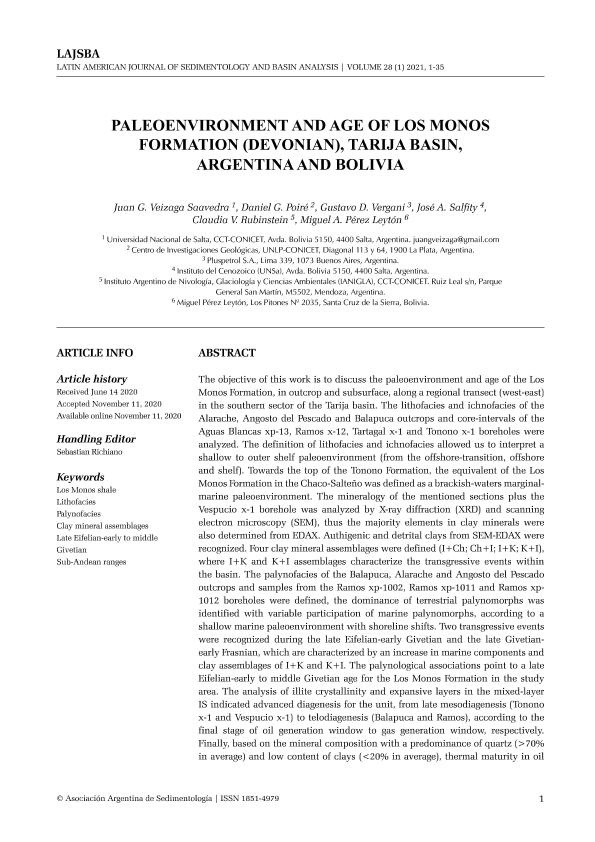Artículo
Paleoenvironment and age of Los Monos Formation (Devonian), Tarija Basin, Argentina and Bolivia
Veizaga Saavedra, Juan Gonzalo ; Poiré, Daniel G.; Vergani, Gustavo Dardo; Salfity, Jose Antonio
; Poiré, Daniel G.; Vergani, Gustavo Dardo; Salfity, Jose Antonio ; Rubinstein, Claudia Viviana
; Rubinstein, Claudia Viviana ; Pérez Leytón, Miguel A.
; Pérez Leytón, Miguel A.
 ; Poiré, Daniel G.; Vergani, Gustavo Dardo; Salfity, Jose Antonio
; Poiré, Daniel G.; Vergani, Gustavo Dardo; Salfity, Jose Antonio ; Rubinstein, Claudia Viviana
; Rubinstein, Claudia Viviana ; Pérez Leytón, Miguel A.
; Pérez Leytón, Miguel A.
Fecha de publicación:
11/2020
Editorial:
Asociación Argentina de Sedimentología
Revista:
Latin American Journal of Sedimentology and Basin Analysis
ISSN:
1851-4979
Idioma:
Inglés
Tipo de recurso:
Artículo publicado
Clasificación temática:
Resumen
The objective of this work is to discuss the paleoenvironment and age of the Los Monos Formation, in outcrop and subsurface, along a regional transect (west-east) in the southern sector of the Tarija basin. The lithofacies and ichnofacies of the Alarache, Angosto del Pescado and Balapuca outcrops and core-intervals of the Aguas Blancas xp-13, Ramos x-12, Tartagal x-1 and Tonono x-1 boreholes were analyzed. The definition of lithofacies and ichnofacies allowed us to interpret a shallow to deep marine paleoenvironment (from the offshore-transition, offshore and shelf). Towards the top of the Tonono Formation, the equivalent of the Los Monos Formation in the Chaco-Salteño was defined as a brackish-waters marginal-marine paleoenvironment. The mineralogy of the mentioned sections plus the Vespucio x-1 borehole was analyzed by X-ray diffraction (XRD) and scanning electron microscopy (SEM), thus the majority elements in clay minerals were also determined from EDAX. Authigenic and detrital clays from SEM-EDAX were recognized. Four clay mineral assemblages were defined (I+Ch; Ch+I; I+K; K+I), where I+K and K+I assemblages characterize the transgressive events within the basin. The palynofacies of the Balapuca, Alarache and Angosto del Pescado outcrops and samples from the Ramos xp-1002, Ramos xp-1011 and Ramos xp-1012 boreholes were defined, the dominance of terrestrial palynomorphs was recognized with variable participation of marine palynomorphs, according to a shallow marine paleoenvironment with shoreline shifts. Two transgressive events were identified during the late Eifelian-early Givetian and the late Givetian-early Frasnian, which are characterized by an increase in marine components and clay assemblages of I+K and K+I. The palynological associations pont to a late Eifelian-early to middle Givetian age for the Los Monos Formation in the study area. The analysis of illite crystallinity and expansive layers in the mixed-layer IS determined advanced diagenesis for the unit, from late mesodiagenesis (Tonono x-1 and Vespucio x-1) to telodiagenesis (Balapuca and Ramos), according to the final stage of oil generation window to gas generation window, respectively. Finally, based on the mineral composition with a predominance of quartz (>70% in average) and low content of clays (<20% in average), thermal maturity in oil and gas window, the important thickness in the subsurface (700-1000 meters) and significant lateral continuity (>100 km2), the unit has some of the attributes to be considered as a shale-type unconventional reservoir.
Archivos asociados
Licencia
Identificadores
Colecciones
Articulos(IANIGLA)
Articulos de INST. ARG. DE NIVOLOGIA, GLACIOLOGIA Y CS. AMBIENT
Articulos de INST. ARG. DE NIVOLOGIA, GLACIOLOGIA Y CS. AMBIENT
Citación
Veizaga Saavedra, Juan Gonzalo; Poiré, Daniel G.; Vergani, Gustavo Dardo; Salfity, Jose Antonio; Rubinstein, Claudia Viviana; et al.; Paleoenvironment and age of Los Monos Formation (Devonian), Tarija Basin, Argentina and Bolivia; Asociación Argentina de Sedimentología; Latin American Journal of Sedimentology and Basin Analysis; 28; 1; 11-2020; 1-35
Compartir



